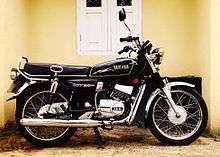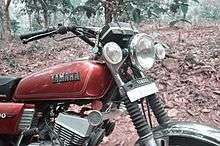Yamaha RX 100
 Yamaha RX 100 | |
| Manufacturer | Yamaha |
|---|---|
| Also called | RX |
| Parent company | Escorts |
| Production | 1985–1996 |
| Predecessor | Rajdoot 350 |
| Successor | RXG, RX135 TIGER, RXZ. |
| Class | Classic |
| Engine | 98 cc two-stroke, reed valve, air-cooled, single-cylinder, gasoline seven-port torque induction |
| Top speed | 120kmph (full conditioned) |
| Power | 11 HP (8.206 kW) @ 8500 RPM |
| Torque | 10.39 Nm (1.06 kgf-m or 7.66 ft.lbs) @ 6500 RPM |
| Transmission | four-speed constant mesh, multiplate clutch |
| Suspension | Telescopic fork front, swing arm (adjustable five-position) rear |
| Brakes | Expanding Drum (both front and rear) |
| Tires | Wire spoked, 2.50-inch × 18-inch (4-ply rating) front tyre, 2.75-inch × 18-inch (6-ply rating) rear tyre |
| Wheelbase | 1240 mm |
| Dimensions |
L: 2040 mm W: 740 mm H: 1060 mm |
| Seat height | 765 mm (29.5 inches) if adjustable, lowest setting |
| Weight |
95 kg (dry) 103 kg (wet) |
| Fuel capacity | 10.5 L (2.3 imp gal; 2.8 US gal) |
| Oil capacity | 0.650 L (0.687 US qt) |
| Fuel consumption | 30-35 km/L |
| Turning radius | 2100 mm |
The Yamaha RX 100 was a motorcycle manufactured by Yamaha from 1985 to 1996 and distributed in India.[1]
History

Following the dismal sales[2] of the Rajdoot 350, Yamaha needed to make a comeback product, and the recent success of Suzuki's AX 100 demonstrated the potential of small-capacity motorbikes in India.
In November 1985, Yamaha released the RX 100 to widespread acclaim. The appeal came largely from the surprise that its 100 cc (6.1 cu in) engine could deliver as much raw power as it did. Race conductors and authorities often double checked the engine by opening the engine block to make sure it was actually 100 cc.
The RX 100 was quickly adopted by racers who recognized its potential in drag racing. Various modifications such as expansion chambers, porting, engine tuning, sprocketing and changing wheel sizes (16, 17 and 18 in (410, 430 and 460 mm)) became fairly common. Furthermore, upgrades such as bigger carburetors, air filters, quicker throttle, disc brakes, an additional 5th gear, race pistons, racing CDI systems, upgraded tires and suspension dampening were released, allowing riders to customize their bikes.

Tuned RX 100's have completed the so-called standing start quarter-mile in about 14 seconds – a formidable figure, considering the much larger BMW-S1000RR 4-Cylinder 1,000 cc (61 cu in) bike can cover one-quarter mile (0.4 km) in 10.2 seconds. The bikes was manufactured between 1985 and 1987 and were knock-down kits, (CKD), from Japan and were assembled in India. Only the model produced in Japan had disc brakes.
The bikes were sold in Peacock Blue, Cherry Red and Metallic Black stock colors. The only major changes that the bike underwent was upgrading from a 6-volt electrical system to a 12-volt system with the addition of a CDI (capacitor discharge ignition) system for improved ignition and timing. The bike's production lasted from November 1985 – March 1996. Stricter emission laws and regulations in India made the continuing production of the RX100 impossible.
The CKD model was then followed by the 11.8 bhp (8.8 kW), 132 cc (8.1 cu in) RXG, with a taller primary and secondary reduction. It had the same lightened flywheel from the RX 100 that causes a jerky ride. It was replaced by the manufacturer by a heavier flywheel the following year. Then came the RXZ in 1997, with a new chassis and a shorter wheelbase with the same primary reduction ratio as the RX100 but with a taller final reduction. The RXZ was launched with sportier bodywork and produced 12 bhp (8.9 kW) at 6,500rpm. Following the RXZ, the RX135 was launched in 1998 with the same engine as the RXZ but using the same chassis as the RX100 or RXG. The RX135 saw a moderate success due to its refined power output and better fuel economy. Finally, in 2000 Yamaha launched the 14 bhp (10 kW), 7,500rpm RX135 5 speed with a catalytic converter silencer. It failed in the market due to its poor fuel economy and was discontinued after two years. The RX135 was later recognized as the quickest RX and has a cult status due to its rarity. A 5-speed variant of the RXZ with front disc brakes also had a limited release in 2001 at a premium price tag.
The final variant was a 4-speed RX135 with a catalytic converter silencer, sporting a fuel gauge and speedometer with white dials which was sold very briefly from 2003 to 2005.
Successors
The Yamaha RX 100 production run lasted from November 1985 to March 1996. The model was followed by the 132 cc RXG, (11.8 BHP). This model was the reply to the stricter emissions controls, which later became the norm. RXG had an economy-minded engine configuration with the ports tuned to increase fuel-efficiency and decrease exhaust gas. However, in the market. The Japanese manufacturers responded in late 1997 with the Yamaha RX-135 and the RX-Z which had a tachometer and a sportier headlamp and body. Both were mechanically the same and the RX-135 received a lukewarm response. The market also saw five-speed versions of the RX-135s and RX-Z. The final variant was a four-speed RX135 with a small type catalytic converter, sporting a fuel gauge and a speedometer with white dials which was sold very briefly in 2003–2005.
The Yamaha RX series is becoming one of the most desired second-hand motorcycles in India. Prices have skyrocketed since its demise. Many RX groups have been active across India. The Yamaha RX 100 has a large cult following on social media platforms such as Facebook. Groups like <NHZRIDEZ>, TEAM Rx, Yamaha RX Club(YRC) have been actively conducting rides.
Yamaha India has released a successor to the RX 100 series. On April 14th 2016, the Yamaha Saluto RX 110 was released in India. It is a 110 cc (6.7 cu in), four-stroke, air-cooled motorcycle weighing 98 kg (216 lb). Yamaha is projecting 1.2 million unit sales for 2017. The Saluto RX also comes in a 125 cc (7.6 cu in) variant.[3][4]
References
- ↑ "Yamaha RX 100 (History)". www.xbhp.com. Retrieved 2017-11-11.
- ↑ "A brief history of RD 350 sold in India – Just Motorcyclin' Around". Just Motorcyclin' Around. 2000-12-31. Retrieved 2017-11-11.
- ↑ "Yamaha Saluto RX 110 Price, Specifications, Mileage, Colours". IndiaCarNews.com. 14 April 2016. Retrieved 29 October 2017.
- ↑ "Yamaha 100cc bike to be launched on 21st August – EXCLUSIVE". MotorOctane.com. 18 August 2016. Retrieved 29 October 2017.
External links
